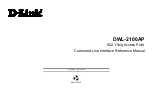
16
Cisco Catalyst 9117AX Series Access Points
Step 2
Observe the access point LED (for LED descriptions, see
“Checking the Access Point LEDs” section on
).
a.
When you power up the access point, it begins a power-up sequence that you can verify by observing the
access point LED. If the power-up sequence is successful, the discovery and join process begins. During this
process, the LED blinks sequentially green, red, and off. When the access point has joined a controller, the
LED is blinking green if no clients are associated or blue if one or more clients are associated.
b.
If the LED is not on, the access point is most likely not receiving power.
c.
If the LED blinks sequentially for more than 5 minutes, the access point is unable to find its primary,
secondary, and tertiary Cisco wireless controller. Check the connection between the access point and the Cisco
wireless controller, and be sure the access point and the Cisco wireless controller are either on the same subnet
or that the access point has a route back to its primary, secondary, and tertiary Cisco wireless controller. Also,
if the access point is not on the same subnet as the Cisco wireless controller, be sure that there is a properly
configured DHCP server on the same subnet as the access point. See the
Step 3
Reconfigure the Cisco wireless controller so that it is not the Master.
Note
A Master Cisco wireless controller should be used only for configuring access points and not in a
working network.
















































